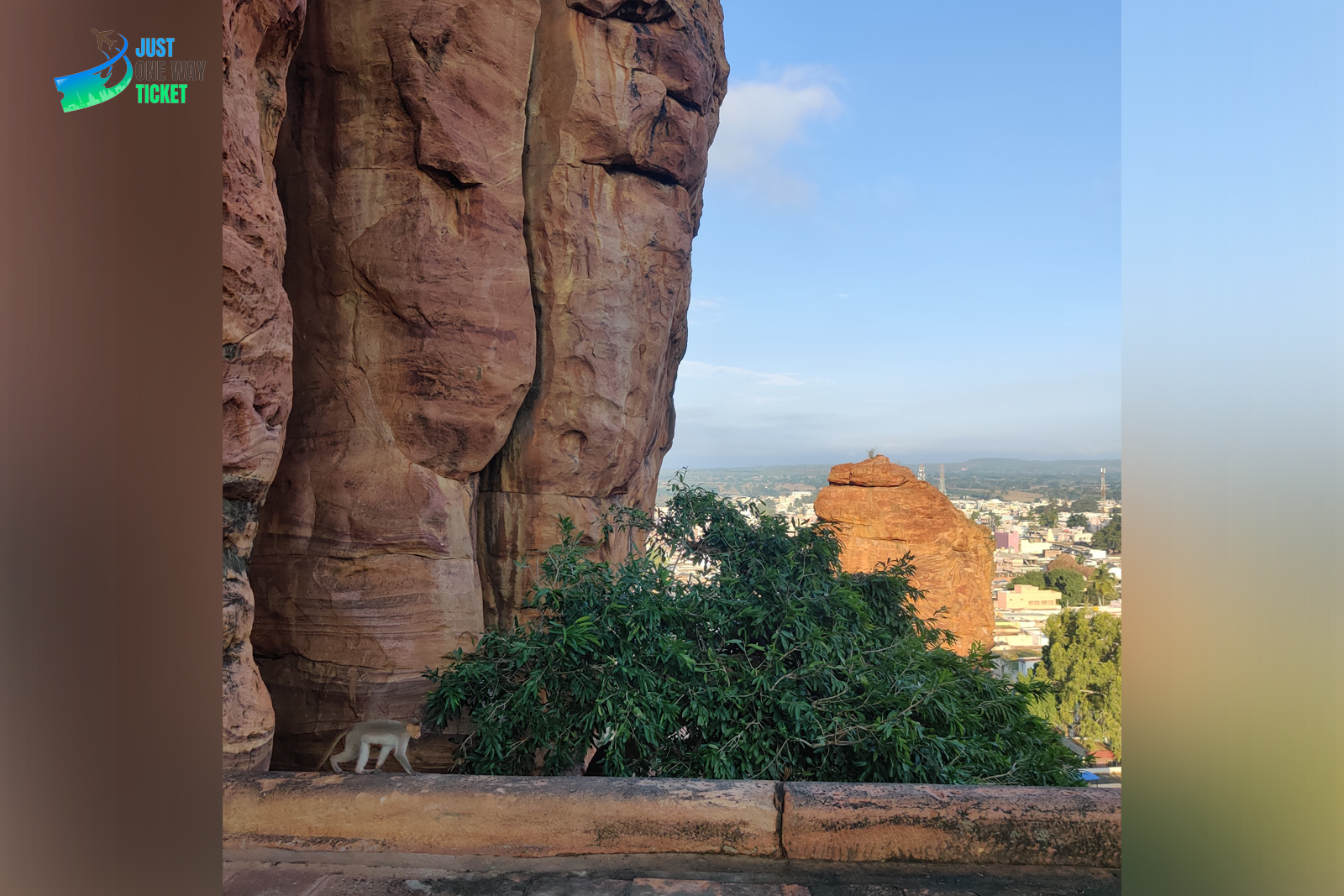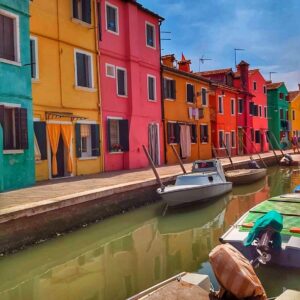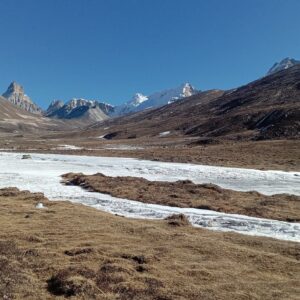Time saved is time gained
Ticking off my bucket list destination, I find myself on the flight to Belgaum from Nasik. Surprised yes, that’s true, and that too at a very reasonable cost. Thanks to the domestic flight network gaining momentum.
Once in Belgaum, we are driving 135 km to Badami by a hired vehicle. The natural sound and light show welcomes us, with heavy showers cooling the air in an otherwise hot State. A few Kilometres on wards we are amidst clear skies with the sun peeping in from behind the clouds, and do not” forget for great sunsets you need cloudy skies”.
We set our foot in Badami for our stay at the Fern which gave a very competitive accommodation at a very reasonable cost.
The Chalukya dynasty was founded by Pulakeshin, also known as the Badami Chalukya, who ruled from Vatapi and was instrumental in bringing Karnataka under one rule. They were connoisseurs of arts and culture.
First sight of the gorgeous Mountain Cliff
As I draw the drapes my room , I face the gigantic red Iron-rich rock mountain cliffs. They are mega in size and almost in my face. With early morning sun peeking from behind It’s a challenge for me to say who is more crimson the sun or the mountains. But my smile broadens as I realize to have woken up in the powerful Chalukya Dynasty capital of the Golden Era Known as Vatapi, set in between two steep mountain cliffs , which is today’s Badami, situated in the Bagalkot District of Karnataka.
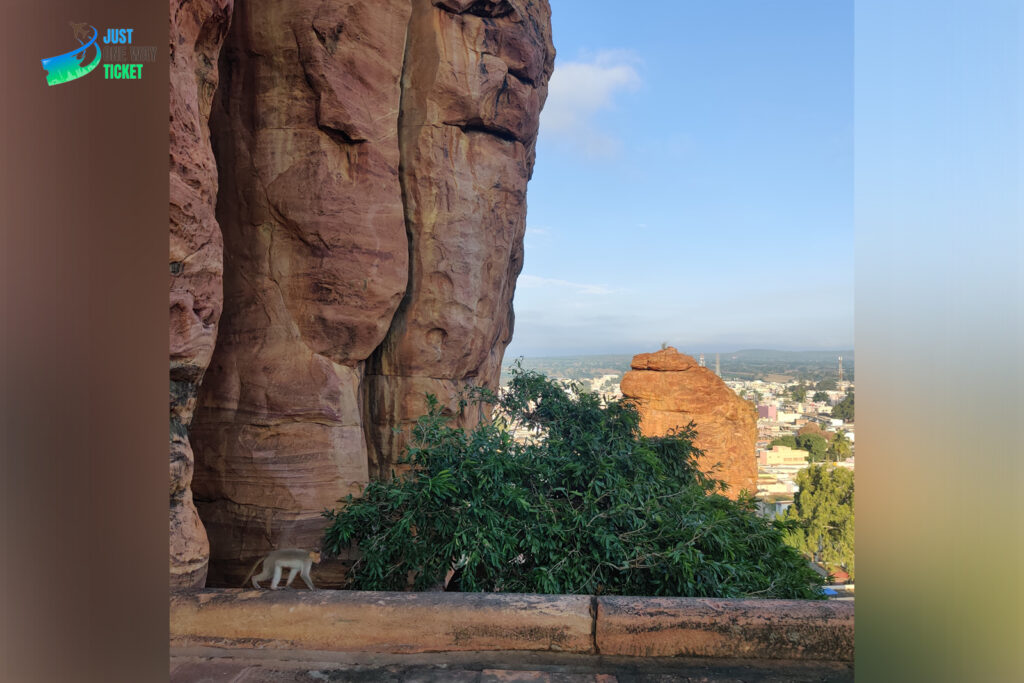
The Mountain Cliff
As a traveler, it’s my responsibility
Eager to walk to see the most-awaited and spoken about temple caves I walk to the southern side of Agastya Lake. The approach towards the UNESCO world heritage site is just not what it should be. Inhabited and encroached by humans, domestic chores happen on the approach road and, today’s Varaha (boars) are loitering around and I start a monologue with myself.
Why isn’t the infrastructure for tourism developed in my country when hordes of tourists visit these sites? I had to push myself after the first put-off to reach the first set of temple caves? Though forlorn, I am stunned and attacked at the same time.
Stunned with the beauty and attacked by the residents of the Cave temple. The army of monkeys make sure, to convey their annoyance for encroaching their space and I hear two shrill tones, monkeys screeching and humans screaming. It’s an undeterred army going about their day-to-day chores and we are notified that we are unwelcome.
But I am undeterred too, as I hold my ground and come close to the Boulders and rocks, I am intimidated by their sheer size and shape. It’s unimaginable unless you see to believe, how they stand balanced in the same position for millions of years without any external support. So huge are they that the temple caves are chiseled in the rock faces.
Blue pearl of a water body
Set in the backdrop of man-made Agastya Teertha (lake) the Blue pearl of a water body and the green vegetation cropping from in between the boulders is enchanting. The boulders are in shades of Red, Peach. Beige and brown and in every geometrical shape flawlessly balancing on each other is an enigma for me.
CAVE ONE
This enigma unfolds as I enter the first out of the four cave temples dedicated to the fiery God Lord Shiva, Known for his Tandav dance. The Natraja with 18 arms, one of the forms of Shiva is said to depict 81 dance poses (Mudra) of the Natya Shastra and is a sure shot Inspiration for the dancing Fraternity. At the cave, though the dance form is said to be a lalit tandav, meaning a happy Tandav. A historian depicted Lord Shiva’s 18 hands figurine as time division of the day also known as the cosmic wheel.
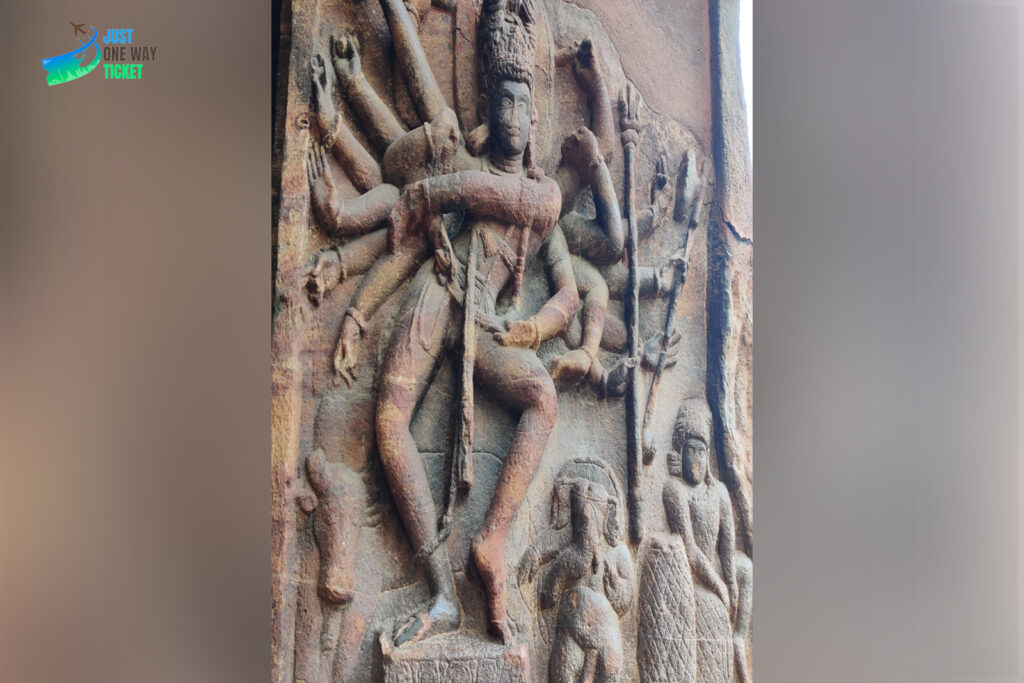
Lord Shiva in the Lalit Tandava pose
CAVE TWO
The second cave temple is similar to the first one but primarily dedicated to Vishnu and his Avatars. A chiseled figure of Vishnu in Varaha (boar) avatar is a major attraction with a legend of lord Vishnu rescuing the Goddess earth is depicted through many carving and inscriptions.
CAVE THREE
Among the set of four temples, the third and the largest one is dedicated to Lord Vishnu and is the earliest dated Hindu temple in the Deccan region. Being most majestic with hundred feet deep cave with inscriptions from the Puranas and Images of Lord Narasimha dating back to 578 CE is said to belong to the reign of Keerti Verma of the Chalukya Dynasty.

CAVE FOUR
The fourth cave in the set has Lord Mahavira and the Jain Tirthankaras. Panoramic View from the topmost cave of the Badami Town, the Fort, and the Bhoothnath group temples is just majestic. You tend to relax, visiting the era and visualizing how life was, but that is momentary with the miscreants around, and you are always in a caution mode.
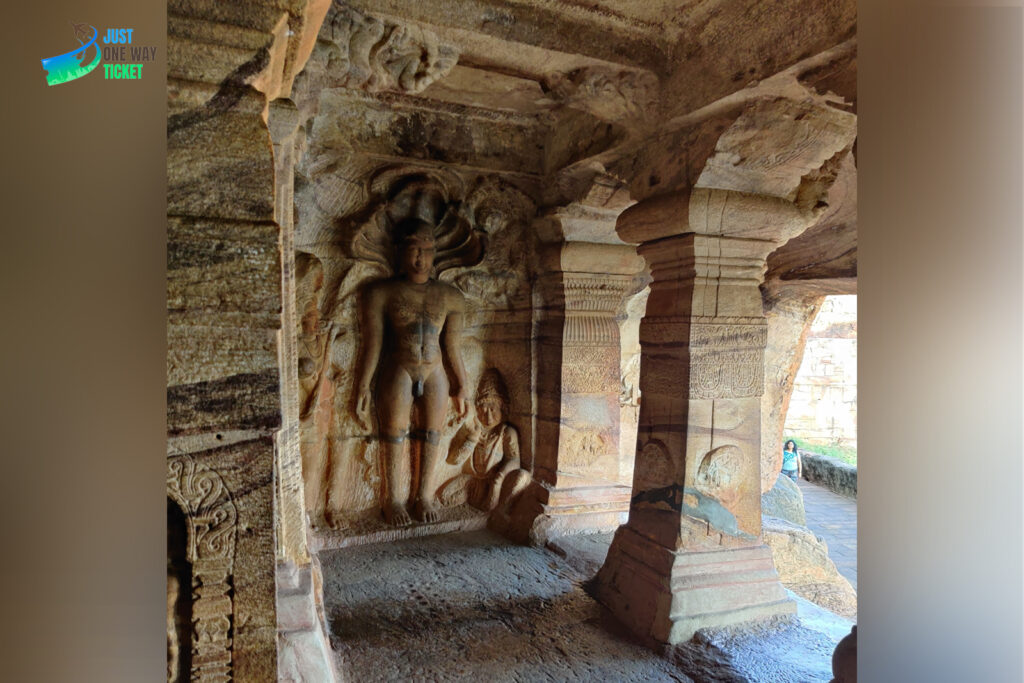
The Tirthankaras in Cave four
Enigmatic Insight
These Cave temples were sculpted in sandstone, and Badami rock-cut architecture. Discovered in the 6th century. Every cave has some familiar floor plan, Pillared entry with the Ganas or Dwarpals welcoming. Sabha Mandap is supported by multiple pillars, and the inner sanctum is carved with various mythological figurines and all this is done in face of one Monolithic rock.
Each cave is separated by a flight of stairs gaining height. All temples have Fresco Paintings on the ceilings and in a few places you can see the color intact even today. The excavations until recent have found many other caves and medieval era temples.
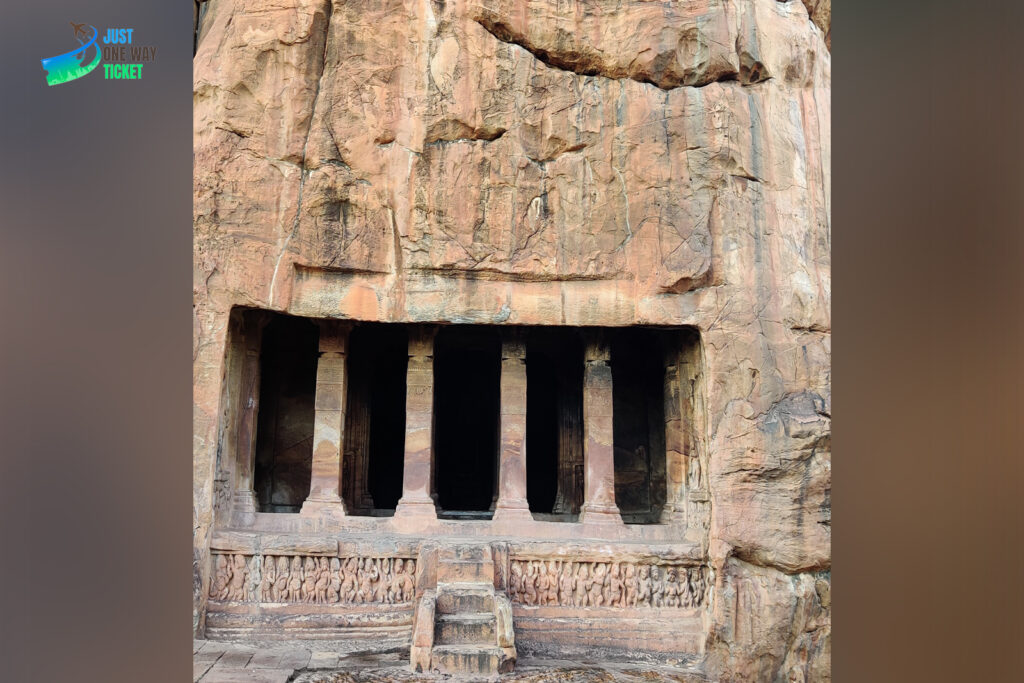
Seeing is believing
See to believe
The questions which come to my mind are how were these huge rocks formed? How do they stand even today? How were the caves carved with beautiful carvings? I do find my answers as a get lost in the rocks their sedimentation and the balancing act.
As it dawns on me I have stopped believing the mythological tales and took them as mere stories to be told by my grandparents. I remember my elegant grandma sunbathing with me in the chilly winters entertaining me with many of these I enjoyed their love and the stories and they did intrigue me then.
The beliefs were formed and cemented too, but as I grew, logic became more realistic and these seem to be unrealistic. Traditions were followed, but the base was diluted.
Today as I stand at the oldest school of Architecture, I am bound to believe the mythology, as every carved figure and pillar resembles all that I heard from my Grandma. It is documented proof bearing the name of the craftsmen and I am stunned.
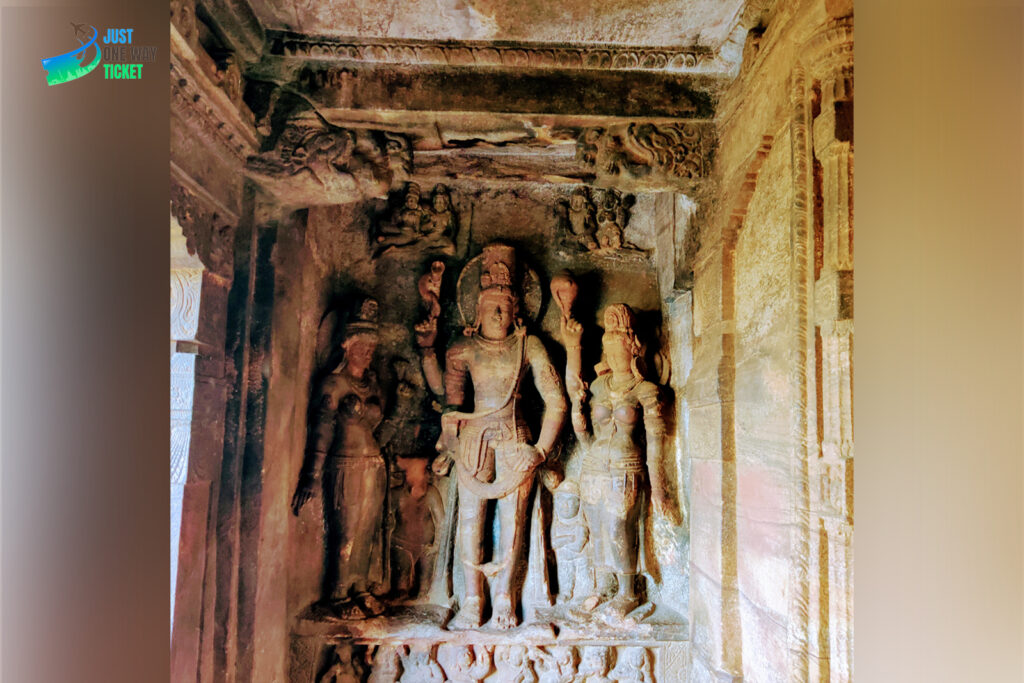
Mythology is the unfolding of a new perspective
Love with mythology
In this phase of life, I reemphasize all the mythological tales and do get answers to my above questions, and understand how important are the scriptures of Ramayana, Mahabharata, Vishnu Purana, and Shiv lilamrut.
As these Rocks Stand as a geographical phenomenon of an eruption from a volcano so do the Cave temples from millions of years and if these were made millions of years back they too must have known mythology to carve and leave a legacy for us to see.
The army of monkeys escorts me down to move on to the Northern side of Agastya Lake to explore the fort and Bhootnath group of temples…..Do follow the upcoming blog on temples.
Tips
☞ Carry hands-free backpack to keep away Monkeys
☞All belongings must be in the backpack
☞ Start early for cave temples.
☞ Walk around to understand better
☞ Hire a guide and help sustainable Travel

